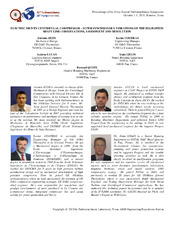| dc.contributor.other | Turbomachinery Symposium (42nd : 2013) | |
| dc.creator | Seon, Jeremie | |
| dc.creator | Lucas, Antoine | |
| dc.creator | Coudray, Xavier | |
| dc.creator | Gelin, Alain | |
| dc.date.accessioned | 2017-10-04T19:34:03Z | |
| dc.date.available | 2017-10-04T19:34:03Z | |
| dc.date.issued | 2013 | |
| dc.identifier.uri | https://hdl.handle.net/1969.1/162946 | |
| dc.description | Lecture | en |
| dc.description.abstract | An unacceptable vibratory behavior was encountered in 2012 during the full load string test of an electric driven centrifugal compressor. The vibrations were observed on the high speed part of the shaft line and both compressor and gearbox exhibited vibratory levels higher than 50 microns peak to peak on the second harmonic (H2) of the rotational speed. The centrifugal compressor is driven via a variable speed electrical motor through a gearbox. The main characteristics of the shaft line are the following: 9 MW electrical motor running from 1250 to 1875 rpm to cover the whole operating speed range of the compressor; Gearbox with a speed ratio of 7.035; Centrifugal compressor (back to back arrangement) from 72 to 167 bara (first stage) and from 165 to 307 bara (second stage); Low speed and high speed flexible couplings of membrane type technology. All individual components of the train were successfully tested prior to be integrated to constitute the complete shaft line package. The aerodynamics performances of the compressor were as expected, and the gear box and the compressor did not exhibit any abnormal vibratory behavior. During the ASME PTC10 Type 1 string test of the complete package, super-synchronous vibrations were detected on the compressor and the pinion of the gearbox while the compressor was running at around 94% speed. Extensive theoretical and experimental investigations were conducted to identify the root cause of the 2X vibration component with the full involvement of the different components suppliers: Potential excitation coming from the electrical drive system; Potential excitation coming from the gearbox; Aerodynamic excitation coming from the compressor; Torsional resonance and/or interaction with lateral behavior; Contact, alignment, lubrication influence, type of bearings; Lateral critical speed combination (train shaft line analysis); Type of coupling, non linearity and lack of flexibility. The issue was solved within three months thanks to the following modifications: Gearbox bearing span increase and reduction of the overhang, by modifying the existing pinion design; New coupling with reduced moment. The paper will describe the investigations that were conducted to understand the root cause of the supersynchronous vibrations as well as the modifications that have been successfully implemented. | en |
| dc.format.medium | Electronic | en |
| dc.format.mimetype | application/pdf | |
| dc.language.iso | en | |
| dc.publisher | Texas A&M University. Turbomachinery Laboratories | |
| dc.relation.ispartof | Proceedings of the 42nd Turbomachinery Symposium | en |
| dc.subject.lcsh | Turbomachines | en |
| dc.title | Electric Driven Centrifugal Compressor - Super Synchronous Vibrations of the High Speed Shaft Line: Observations, Assessment and Resolution | en |
| dc.type.genre | Presentation | en |
| dc.type.material | Text | en |
| dc.identifier.doi | https://doi.org/10.21423/R1306G | |


